International Journal of Computer Network and Information Security @ijcnis
Статьи журнала - International Journal of Computer Network and Information Security
Все статьи: 1166
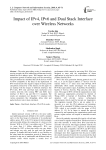
Impact of IPv4, IPv6 and dual stack interface over wireless networks
Статья научная
The entire networking society is tremendously moving towards the IPv6 addressing architecture leaving behind the IPv4 address space. This happens due to the tremendous growth of Internet usage over the networking. The government has mandated that all the devices would be IPv6 compatible as the delay in the deployment of IPv6 would result in the negative impact of future growth and global connectivity of the internet. In this paper we are dealing with the impact of different interfaces like IPv4 only, IPv6 only and Dual stack mechanism over wireless networks with varying PHY and MAC layer interface of 802.11 a/g and 802.11 b standards. The results are simulated over Qualnet 5.1 simulator with various parameters like throughput, delay, jitter and packet delivery ratio is been calculated.
Бесплатно
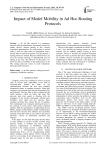
Impact of Model Mobility in Ad Hoc Routing Protocols
Статья научная
An Ad Hoc network is a temporary network without infrastructure, dynamically formed by mobile devices without turning to any existing centralized administration. To send packets to remote nodes, a node use other nodes as intermediate relays, and ask them to transmit its packets. For this purpose, a routing protocol is needed. Because mobile devices are used, the network topology is unpredictable and can change at any time. The objective of this paper is to know the effect of mobility on the performance of Ad Hoc routing protocols, based on multi simulations performed with Glomosim.
Бесплатно

Impact of Physical Layer Jamming on Wireless Sensor Networks with Shadowing and Multicasting
Статья научная
This paper analyzes the impact of a physical layer jamming on the performance of wireless sensor networks by performing exhaustive comparative simulations using multicasting and by employing varying intensity of shadowing (constant and log normal). Comprehensive result analysis reveals that jamming drastically degrades the legitimate traffic throughput in a network, and, the constant shadowing approach is a better fit for a static network, both, under static as well as mobile jammer environments, as compared to the log normal one. An improvement in sink-node packet delivery ratio by 15.02 % and 16.58 % was observed with static and mobile jammer environments respectively, under multicasting and constant shadowing mean of 8.0. Further, average sink-node packet delivery ratio with constant shadowing shows an improvement of 4.15% and 5.94%, using static and mobile jammer environment respectively, in comparison to the values obtained under log normal shadowing based network.
Бесплатно
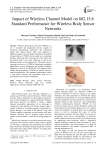
Impact of Wireless Channel Model on 802.15.6 Standard Performance for Wireless Body Sensor Networks
Статья научная
Wireless Body Sensor Network (WBAN) is a set of wearable and implantable devices capable of measuring physiological parameters and monitoring patient with chronic disease where early diagnosis is highly demanded. Several models introduced the general characterization of WBAN devices path loss considering possible shadowing due to obstruction of the signal (by the human body or any other obstacles) as well as the different postures of the human body. This paper aims at reporting an overview of WBSNs technologies, particular applications, system architecture and channel modeling. Emphasis is given to the IEEE 802.15.6 standard which enables the development of WBAN for medical and non-medical applications. The standard's performance within a time based variation and log-distance path loss is presented based on various simulations.
Бесплатно
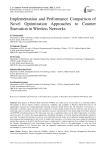
Статья научная
Data packets in Wireless Mesh Networks (WMNs) are routed across several nodes in a multi-hop fashion. The Quality of Service (QoS), seamless connectivity, reliability, and scalability of Wireless Mesh Networks are all significantly impacted by routing approaches. Routing protocols should enforce the fair utilization of resources i.e. bandwidth or channel among network nodes irrespective of their spatial location from the Gateway. The two-hop or multi-hop nodes in wireless mesh networks experience resource starvation due to the functioning of the MAC protocol and TCP/TP networking protocol. The Starvation issue has a significant impact on the QoS requirements of wireless mesh networks. It is known that using appropriate scheduling techniques in network planning substantially minimizes starvation. To reduce the starving of resources to the multi-hop network nodes, novel optimized routing algorithms have been proposed and implemented in this work. To address the starvation, a GA-based cross-layer optimized scheduling method that operates at the MAC and Network layers is implemented. A hybrid approach that combines the features of the Genetic Algorithm (GA) and Gravitational Search Algorithm (GSA) is also implemented to solve the local minimum problem in GA. Results show that the suggested optimization methods greatly improve the fairness performance of wireless mesh networks.
Бесплатно
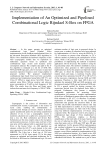
Implementation of An Optimized and Pipelined Combinational Logic Rijndael S-Box on FPGA
Статья научная
In this paper, presents an optimized combinational logic based Rijndael S-Box implementation for the SubByte transformation(S-box) in the Advanced Encryption Standard (AES) algorithm on FPGA. S-box dominated the hardware complexity of the AES cryptographic module thus we implement its mathematic equations based on optimized and combinational logic circuits until dynamic power consumption reduced. The complete data path of the S-box algorithm is simulated as a net list of AND, OR, NOT and XOR logic gates, also for increase in speed and maximum operation frequency used 4-stage pipeline in proposed method. The proposed implemented combinational logic based S-box have been successfully synthesized and implemented using Xilinx ISE V7.1 and Virtex IV FPGA to target device Xc4vf100. Power is analized using Xilinx XPower analyzer and achieved power consumption is 29 mW in clock frequency of 100 MHz. The results from the Place and Route report indicate that maximum clock frequency is 209.617 MHz.
Бесплатно
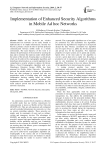
Implementation of Enhanced Security Algorithms in Mobile Ad hoc Networks
Статья научная
Mobile Ad hoc Networks are wireless infrastructure less networks can beeasily formed or deployed due to its simple infrastructure. Security has become a primary concern in order to provide protected communication between mobile nodes in a hostile environment. The main objective of this work is to enhance the performance of the network by securing the data and to minimize the malicious nodes which disturb the stream of the network. Securing data is a critical task which can be achieved by cryptographic algorithms and disturbance detection plays as a crucial ingredient in any comprehensive security solution to address the threats.Hence a Novel Cryptographic Algorithm with a new Disturbance Detection System (DDS) has been proposed for Mobile Adhoc Networks. This method prevents the outside attacks to obtain any information from any data exchange in network and also use promiscuous mode of working along with rating and collaborative decision making based on multiple threshold values.The proposed algorithm was implemented and simulated in the Glomosim and the result analysis proved that the performance of the network is increased.
Бесплатно
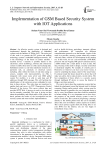
Implementation of GSM Based Security System with IOT Applications
Статья научная
An effective security system is designed and implemented through the application of embedded systems and the Internet of Things (IoT). The main goal of this work is to present the IoT system and modern technology systems / embedded intelligent networks. IoT is the technology of the future in contact machine / machine device / machine is possible thanks to the electronics, sensor technology, software and connectivity system to enable these items to collect and exchange data. Embedded system is a real-time mainframe structure on a particular task, an automatic or electrical system including, often within the limits of real-time raking as sensors, modules with microcontrollers, etc...This is integrated with sensor main server and GSM global system For mobile), it is able to send data and IP addresses through SMS message. This will facilitate the identification of the unknown person embedded in real-time in these devices. The video data are transferred to another back-end server via TCP (Transmission Control Protocol) of the device. This server collects data and provides HTTP Web. A browser is used to view data and can be remotely controlled. This type is giving an idea about the probability and effectiveness of the system, this thesis presents the results of the investigation into the security system and some realistic implementations.
Бесплатно
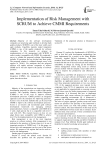
Implementation of Risk Management with SCRUM to Achieve CMMI Requirements
Статья научная
Majority of the software development companies are practicing agile methods to develop high quality products. SCRUM is one of the most widely used agile methods. Capability maturity model integration (CMMI) is one of the quality standards for software companies. In this research, we propose an implementation of risk management with SCRUM in order to make it compatible with CMMI. We conducted a survey to validate the proposed solution. Questionnaire includes 20 questions that are divided into three goals. The proposed solution is validated through survey with support of 70.94%. We anticipate that the proposed solution will enable software companies to achieve CMMI and it will also improve the quality of software products.
Бесплатно
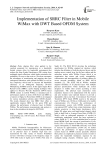
Implementation of SRRC Filter in Mobile WiMax with DWT Based OFDM System
Статья научная
Pulse shaping filter when applied to the symbols generated for transmission in a bandwidth limited systems allow for bandwidth containment that reduces the Inter-Symbol Interference (ISI) arising from multipath signal reflections which further minimizes the probability of errors at the receiver. Wavelets encompass the advantages of transforming and mapping data onto orthogonal subcarriers with optimal flexibility as well as less complexity which leads to increase the bandwidth efficiency of an Orthogonal Frequency Division Multiplexing (OFDM) system. In this paper Square Root Raised Cosine (SRRC) a pulse shaping technique when applied to Discrete Wavelet Transform (DWT) based OFDM system in mobile WiMax is simulated and its performance analysis in terms of Bit Error rate (BER) as a function of Signal to Noise Ratio (SNR) is investigated for various modulation schemes under AWGN channel. The results obtained show that SRRC filter offers to significantly improve BER for the given SNR and enhance the performance of physical layer in Mobile WiMax. The performance measurements and analysis is done in the simulation developed in MATLAB.
Бесплатно
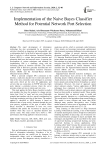
Implementation of the Naive Bayes Classifier Method for Potential Network Port Selection
Статья научная
The rapid development of information technology has also accompanied by an increase in activities classified as dangerous and irresponsible, such as information theft. In the field of network systems, this kind of activity is called intrusion. Intrusion Detection System (IDS) is a system that prevents intrusion and protecting both hosts and network assets. At present, the development of various techniques and methods for implementing IDS is a challenge, along with the increasing pattern of intrusion activities. The various methods used in IDS have generally classified into two types, namely Signature-Based Intrusion Detection System (SIDS) and the Anomaly-Based Intrusion Detection System (AIDS). When a personal computer (PC) connected to the Internet, a malicious attacker tries to enter and exploit it. One of the most commonly used techniques in accessing open ports which are the door for applications and services that use connections in TCP/IP networks. Open ports indicate a particular process where the server provides certain services to clients and vice versa. This study applies the Naïve Bayes classifier to predict port numbers that have the potential to change activity status from "close" to "open" and vice versa. Predictable potential port numbers can be a special consideration for localizing monitoring activities in the future. The method applied is classified as AIDS because it based on historical data of port activity obtained through the port scan process, regardless of the type of attack. Naïve Bayes classifier is determined to have two event conditions that predict the occurrence of specific port numbers when they occur in specified duration and activity status. The study results have shown a 70% performance after being applied to selected test data.
Бесплатно
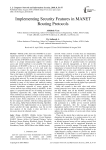
Implementing security features in MANET routing protocols
Статья научная
Mobile ad-hoc network or MANET is an auto-organizing network of mobile nodes. It lacks centralized control and is connected by wireless links. One of the many benefits of MANETs is that it can be utilized where there is no proper infrastructural support for wireless access and wired backbone is not possible. One major drawbacks of MANET is that as it is an infracture-less network, created on the fly, so here each node also functions as a router. So, each node participates in the routing of packets and information along the network. Due to this feature in MANETs, it is convenient to attack one of the nodes of MANET and then organize an attack on the whole network. To, secure the routing protocols in MANETs there are already a number of security features included in many of the unicast and multicast routing protocols. Like the use of unique signature and the use of secured algorithmic approach to secure against the various network layer routing attacks in MANETs. In this paper it is proposed that the use of hashing and secured algorithmic approaches like, Alpha Numeric Routing, when combined can introduce a unique security feature to On-Demand Routing protocols both in its multicast and unicast avatars. Some comparison, is done in the end of the new approach combines with the existing approaches by only using, Alpha Numeric Reflex Routing Algorithm. The outcome of the implementation was as expected, the results satisfied the input algorithms. Last but not the least analysis of the results is done and there is a discussion about the obtained results.
Бесплатно
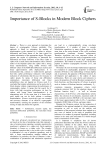
Importance of S-Blocks in Modern Block Ciphers
Статья научная
There is a new approach to determine the degree of cryptographic S-boxes suitability. This approach is based on estimating the number of transformation cycles required for a cipher to achieve differential and linear nature of the state typical for random substitution of the appropriate degree. The paper presents the results of experiments to determine the differential and linear indicators of the Heys cipher (a cipher with a weak linear transformation) and a reduced model of the Rijndael cipher (the cipher with a strong linear transformation), using nibble S-boxes with different values of the XOR table differences maxima and linear approximations table displacements. It is demonstrated that, contrary to widely-known approach that links cipher performance indicators with strength indicators of substitutions that they use, the resistance to cipher attacks by means of linear and differential cryptanalysis (maximum differential and linear probabilities) does not depend on S-boxes used. It is concluded that random substitutions can be used as the S-block designs without compromising the performance of cryptographic ciphers. It means that the search for S-boxes with high encryption performance (at least for ciphers with strong linear transformations) is an unpromising task. At the same time it is shown that a good cipher can not be built without a nonlinear transformation. S-boxes (non-trivial type) are essential and necessary elements of an effective cryptographic transformation, ensuring the operation of the nonlinear mixing of input data blocks bit segments.
Бесплатно
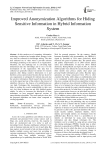
Improved Anonymization Algorithms for Hiding Sensitive Information in Hybrid Information System
Статья научная
In this modern era of computing, information technology revolution has brought drastic changes in the way data are collected for knowledge mining. The data thus collected are of value when it provides relevant knowledge pertaining to the interest of an organization. Therefore, the real challenge lies in converting high dimensional data into knowledge and to use it for the development of the organization. The data that is collected are generally released on internet for research purposes after hiding sensitive information in it and therefore, privacy preservation becomes the key factor for any organization to safeguard the internal data and also the sensitive information. Much research has been carried out in this regard and one of the earliest is the removal of identifiers. However, the chances of re-identification are very high. Techniques like k-anonymity and l-diversity helps in making the records unidentifiable in their own way, but, these techniques are not fully shielded against attacks. In order to overcome the drawbacks of these techniques, we have proposed improved versions of anonymization algorithms. The result analysis show that the proposed algorithms are better when compared to existing algorithms.
Бесплатно
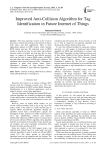
Improved Anti-Collision Algorithm for Tag Identification in Future Internet of Things
Статья научная
The most important research in the world in these days, research that looking at the internet of thing's (IoT) topics and their applications. Most of these applications depend on RFID system, which includes RFID readers and tags. The important issues in RFID system or network are how we can reduce anti-collision between readers to identify and read tags data. In these paper, we suggest an Improved anti-collision protocol, which can be used to connect RFID readers with RFID tags and reduce the number of RFID tag's collisions. The simulation shows that an Improved Class-1 Generation 2 algorithm is better than Slotted Aloha, Class-1 Generation-2 (Number of Tags Known), Class-1 Generation-2 (Number of Tags Unknown) algorithms.
Бесплатно
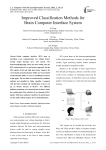
Improved Classification Methods for Brain Computer Interface System
Статья научная
Brain computer interface (BCI) aims at providing a new communication way without brain’s normal output through nerve and muscle. The electroencephalography (EEG) has been widely used for BCI system because it is a non-invasive approach. For the EEG signals of left and right hand motor imagery, the event-related desynchronization (ERD) and event-related synchronization(ERS) are used as classification features in this paper. The raw data are transformed by nonlinear methods and classified by Fisher classifier. Compared with the linear methods, the classification accuracy can get an obvious increase to 86.25%. Two different nonlinear transform were arised and one of them is under the consideration of the relativity of two channels of EEG signals. With these nonlinear transform, the performance are also stable with the balance of two misclassifications.
Бесплатно
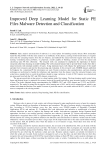
Improved Deep Learning Model for Static PE Files Malware Detection and Classification
Статья научная
Static analysis and detection of malware is a crucial phase for handling security threats. Most researchers stated that the problem with the static analysis is an imbalance in the dataset, causing invalid result metrics. It requires more time for extracting features from the raw binaries, and methods like neural networks require more time for the training. Considering these problems, we proposed a model capable of building a feature set from the dataset and classifying static PE files efficiently. The research work was conducted to emphasize the importance of feature extraction rather than focusing on model building. The well-extracted features help to provide better results when fed to neural networks with minimal numbers of layers. Using minimum layers will enhance the performance of the model and take fewer resources and time for the processing and evaluation. In this research work, EMBER datasets published by Endgame Inc. containing PE file information are used. Feature extraction, data standardization, and data cleaning techniques are performed to handle the imbalance and impurities from the dataset. Later the extracted features were scaled into a standard form to avoid the problems related to range variations. A total of 2381 features are extracted and pre-processed from both the 2017 and 2018 datasets, respectively. The pre-processed data is then given to a deep learning model for training. The deep learning model created using dense and dropout layers to minimize the resource strain on the model and deliver more accurate results in less amount of time. The results obtained during experimentation for EMBER v2017 and v2018 datasets are 97.53% and 94.09%, respectively. The model is trained for ten epochs with a learning rate of 0.01, and it took 4 minutes/epoch, which is one minute lesser than the Decision Tree model. In terms of precision metrics, our model achieved 98.85%, which is 1.85% more as compared to the existing models.
Бесплатно

Improved FCLSD algorithm based on LTE/LTE-A system
Статья научная
In order to meet the high data rate, large capacity and low latency in LTE, advanced MIMO technology has been introduced in LTE system, which becomes one of the core technologies in physical layer. In a variety of MIMO detection algorithms, the ZF and MMSE linear detection algorithms are the most simple, but the performance is poor. MLD algorithm can achieve optimal detection performance, but it’s too complexity to be applied in practice. CLSD algorithm has similar detection performance and lower complexity with the MLD algorithm, but the uncertainty of complexity will bring hardware difficulties. FCLSD algorithm can maximize the advantages of CLSD algorithm and solve difficult problems in practice. Based on advanced FCLSD algorithm and combined with LTE / LTE-A practical system applications, this article designed two improved algorithms. The two improved algorithms can be flexibly and adaptively used in various antenna configurations and modulation scene in LTE / LTE-A spatial multiplexing MIMO system. The Simulation results show that the improved algorithm can achieve an approximate performance to the original FCLSD algorithm; in addition, it has a fixed complexity and could be carried out by parallel processing.
Бесплатно

Improved Multi-Path and Multi-Speed Routing Protocol in Wireless Sensor Networks
Статья научная
In our presented paper by proposing a optimum routing protocol, in some of Quality of Service achieved improvements in the field of reliability in data sending to destination and load balancing in wireless sensor network. In our proposed protocol, to ensure that a data packet correctly send to the destination, it used of an improved hybrid method based on multipath data sending. The routing decisions in this method are by considering the remaining energy of nodes that are in neighbors of sender nodes. Simulation results shows that release rate of data packets in this method is reduced and reliability in data sending to destination is increased. Also, the energy efficiency of sensor nodes effectively improved and thus increase the overall lifetime of wireless sensor networks.
Бесплатно

Improved Trial Division Technique for Primality Checking in RSA Algorithm
Статья научная
The RSA cryptosystem, invented by Ron Rivest, Adi Shamir and Len Adleman was first publicized in the August 1977 issue of Scientific American. The security level of this algorithm very much depends on two large prime numbers. To check the primality of large number in personal computer is huge time consuming using the best known trial division algorithm. The time complexity for primality testing has been reduced using the representation of divisors in the form of 6n±1. According to the fundamental theorem of Arithmetic, every number has unique factorization. So to check primality, it is sufficient to check if the number is divisible by any prime below the square root of the number. The set of divisors obtained by 6n±1 form representation contains many composites. These composite numbers have been reduced by 30k approach. In this paper, the number of composites has been further reduced using 210k approach. A performance analysis in time complexity has been given between 210k approach and other prior applied methods. It has been observed that the time complexity for primality testing has been reduced using 210k approach.
Бесплатно

